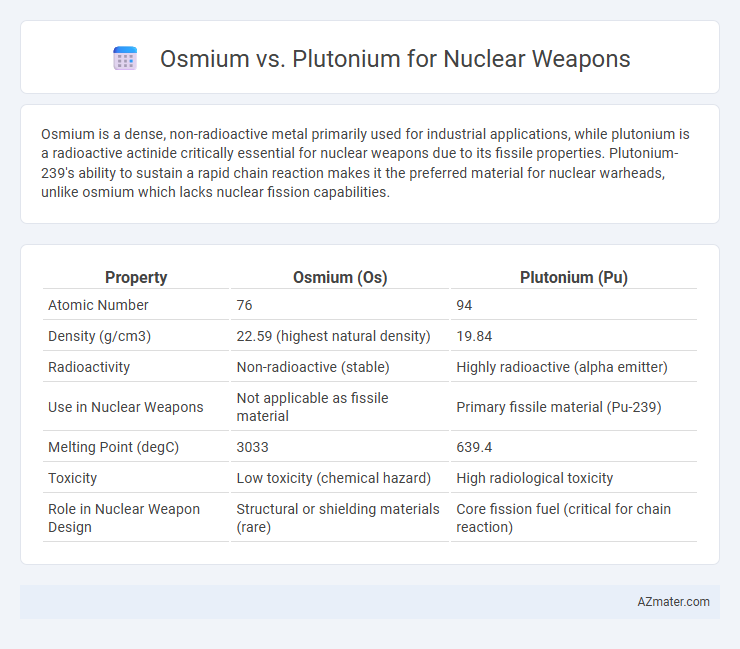Osmium is a dense, non-radioactive metal primarily used for industrial applications, while plutonium is a radioactive actinide critically essential for nuclear weapons due to its fissile properties. Plutonium-239's ability to sustain a rapid chain reaction makes it the preferred material for nuclear warheads, unlike osmium which lacks nuclear fission capabilities.
Table of Comparison
| Property | Osmium (Os) | Plutonium (Pu) |
|---|---|---|
| Atomic Number | 76 | 94 |
| Density (g/cm3) | 22.59 (highest natural density) | 19.84 |
| Radioactivity | Non-radioactive (stable) | Highly radioactive (alpha emitter) |
| Use in Nuclear Weapons | Not applicable as fissile material | Primary fissile material (Pu-239) |
| Melting Point (degC) | 3033 | 639.4 |
| Toxicity | Low toxicity (chemical hazard) | High radiological toxicity |
| Role in Nuclear Weapon Design | Structural or shielding materials (rare) | Core fission fuel (critical for chain reaction) |
Overview of Osmium and Plutonium
Osmium, a dense transition metal with atomic number 76, is primarily known for its extreme density and hardness but lacks the fissile properties necessary for nuclear weaponry. Plutonium, atomic number 94, is a radioactive actinide with isotopes like Pu-239 that are highly fissile and widely used as a core material in nuclear warheads due to their ability to sustain rapid nuclear chain reactions. The fundamental difference lies in plutonium's nuclear reactivity, making it essential for weapon design, whereas osmium serves no practical role in nuclear explosive devices.
Atomic Structure and Properties Comparison
Osmium has an atomic number of 76 with a dense, stable hexagonal close-packed crystal structure, exhibiting high melting point (3045 K) and extreme hardness, but it is not fissile. Plutonium, atomic number 94, possesses multiple allotropes with complex metallic structures and is a radioactive actinide capable of sustaining nuclear fission due to its fissile isotope Pu-239, which has a half-life of 24,100 years. The nuclear weapon applicability of plutonium derives from its ability to undergo rapid chain reactions, unlike osmium, whose atomic stability and lack of fissile isotopes prevent its use in nuclear explosive devices.
Historical Use in Nuclear Weapons
Plutonium-239 has been a cornerstone material in nuclear weapons development since its first use in the 1945 Trinity test and the Nagasaki bombing, owing to its fissile properties and relative availability. Osmium, despite its high density, has never been utilized as a fissile material or core component in nuclear weapons due to lacking appropriate nuclear properties like criticality or neutron economy. Historical nuclear arsenals and documented weapon designs exclusively highlight plutonium isotopes, particularly Pu-239 and Pu-240, as the primary fissile elements powering the world's most destructive nuclear devices.
Fissile Capability of Plutonium
Plutonium-239 exhibits high fissile capability, making it a critical material for nuclear weapons due to its ability to sustain a rapid chain reaction. In contrast, osmium is not fissile and lacks the nuclear properties necessary for weaponization. The superior neutron absorption and fission characteristics of plutonium enable efficient weapon design and yield optimization.
Osmium’s Nuclear Characteristics
Osmium, with a high atomic number of 76 and significant density, does not possess fissile isotopes suitable for nuclear weapon applications, unlike plutonium which contains the fissile isotope plutonium-239 essential for nuclear fission. Although osmium isotopes such as osmium-187 have long half-lives, they do not undergo fission reactions necessary for weaponization. The nuclear characteristics of osmium make it more suitable for industrial uses rather than as material in nuclear weapons, where plutonium's ability to sustain rapid chain reactions is critical.
Availability and Sourcing Challenges
Osmium, a rare and dense platinum-group metal, faces significant availability constraints due to its scarce natural deposits primarily found in Russia, South Africa, and Canada, making large-scale extraction challenging and costly. Plutonium, produced artificially in nuclear reactors from uranium-238, has more accessible sourcing through controlled nuclear reprocessing facilities but involves complex handling and proliferation risks. The scarcity of osmium limits its feasibility for nuclear weapon applications, whereas plutonium's engineered production and established supply chains make it the preferred material despite stringent regulatory controls.
Safety and Handling Concerns
Osmium, a dense and chemically inert metal, is rarely used in nuclear weapons due to its lack of fissile properties, making it safer to handle compared to plutonium. Plutonium, especially isotope Pu-239, is highly radioactive and toxic, posing significant safety and handling challenges such as criticality risks and contamination hazards. Strict protocols and specialized facilities are essential to safely manage plutonium's radiological dangers in nuclear weapon development.
Environmental Impact and Toxicity
Osmium, despite being one of the densest elements, is less suitable for nuclear weapons compared to plutonium due to its limited radioactive properties and nuclear fission potential. Plutonium-239, a fissile material, is highly radioactive and poses significant environmental hazards through long-lived radioactive contamination and toxic chemical exposure. The toxicity of plutonium results in severe health risks from radiation poisoning, while osmium's primary environmental concern involves its toxic osmium tetroxide compound, which is less persistently hazardous than plutonium fallout.
Practical Applications in Weapon Design
Osmium, a dense and stable transition metal, has limited practical applications in nuclear weapon design compared to plutonium, which is a fissile material essential for the core of atomic bombs. Plutonium-239's ability for sustained nuclear chain reactions makes it crucial in the production of efficient, high-yield nuclear weapons. Osmium's mechanical properties may support weapon casing or shielding, but it does not contribute to the nuclear fission process required for explosive yield.
Future Prospects and Strategic Considerations
Osmium's extreme density and rarity make it impractical for nuclear weapon development compared to plutonium, which remains the primary fissile material due to its well-established chain reaction properties and weaponization feasibility. Future prospects for nuclear weapons rely heavily on advanced plutonium isotopes, specifically Pu-239, because of its critical mass efficiency and proven yield reliability. Strategic considerations prioritize materials with established enrichment, handling protocols, and delivery system compatibility, placing plutonium far ahead of osmium in current and foreseeable nuclear arsenals.

Infographic: Osmium vs Plutonium for Nuclear Weapon
 azmater.com
azmater.com